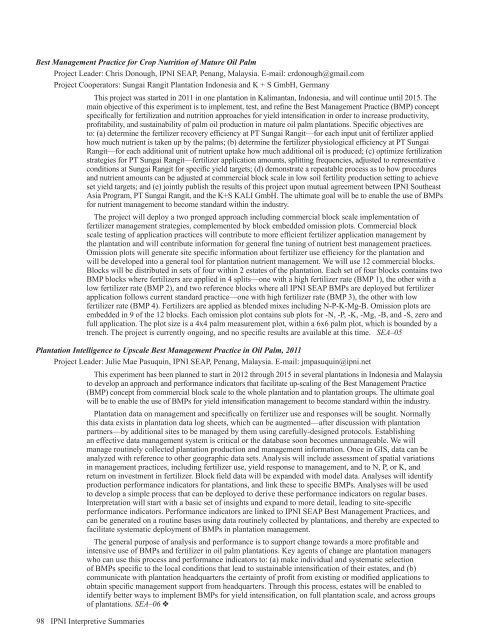Americas and Oceania Group - International Plant Nutrition Institute
Americas and Oceania Group - International Plant Nutrition Institute
Americas and Oceania Group - International Plant Nutrition Institute
Create successful ePaper yourself
Turn your PDF publications into a flip-book with our unique Google optimized e-Paper software.
Best Management Practice for Crop <strong>Nutrition</strong> of Mature Oil Palm<br />
Project Leader: Chris Donough, IPNI SEAP, Penang, Malaysia. E-mail: crdonough@gmail.com<br />
Project Cooperators: Sungai Rangit <strong>Plant</strong>ation Indonesia <strong>and</strong> K + S GmbH, Germany<br />
This project was started in 2011 in one plantation in Kalimantan, Indonesia, <strong>and</strong> will continue until 2015. The<br />
main objective of this experiment is to implement, test, <strong>and</strong> refine the Best Management Practice (BMP) concept<br />
specifically for fertilization <strong>and</strong> nutrition approaches for yield intensification in order to increase productivity,<br />
profitability, <strong>and</strong> sustainability of palm oil production in mature oil palm plantations. Specific objectives are<br />
to: (a) determine the fertilizer recovery efficiency at PT Sungai Rangit—for each input unit of fertilizer applied<br />
how much nutrient is taken up by the palms; (b) determine the fertilizer physiological efficiency at PT Sungai<br />
Rangit—for each additional unit of nutrient uptake how much additional oil is produced; (c) optimize fertilization<br />
strategies for PT Sungai Rangit—fertilizer application amounts, splitting frequencies, adjusted to representative<br />
conditions at Sungai Rangit for specific yield targets; (d) demonstrate a repeatable process as to how procedures<br />
<strong>and</strong> nutrient amounts can be adjusted at commercial block scale in low soil fertility production setting to achieve<br />
set yield targets; <strong>and</strong> (e) jointly publish the results of this project upon mutual agreement between IPNI Southeast<br />
Asia Program, PT Sungai Rangit, <strong>and</strong> the K+S KALI GmbH. The ultimate goal will be to enable the use of BMPs<br />
for nutrient management to become st<strong>and</strong>ard within the industry.<br />
The project will deploy a two pronged approach including commercial block scale implementation of<br />
fertilizer management strategies, complemented by block embedded omission plots. Commercial block<br />
scale testing of application practices will contribute to more efficient fertilizer application management by<br />
the plantation <strong>and</strong> will contribute information for general fine tuning of nutrient best management practices.<br />
Omission plots will generate site specific information about fertilizer use efficiency for the plantation <strong>and</strong><br />
will be developed into a general tool for plantation nutrient management. We will use 12 commercial blocks.<br />
Blocks will be distributed in sets of four within 2 estates of the plantation. Each set of four blocks contains two<br />
BMP blocks where fertilizers are applied in 4 splits—one with a high fertilizer rate (BMP 1), the other with a<br />
low fertilizer rate (BMP 2), <strong>and</strong> two reference blocks where all IPNI SEAP BMPs are deployed but fertilizer<br />
application follows current st<strong>and</strong>ard practice—one with high fertilizer rate (BMP 3), the other with low<br />
fertilizer rate (BMP 4). Fertilizers are applied as blended mixes including N-P-K-Mg-B. Omission plots are<br />
embedded in 9 of the 12 blocks. Each omission plot contains sub plots for -N, -P, -K, -Mg, -B, <strong>and</strong> -S, zero <strong>and</strong><br />
full application. The plot size is a 4x4 palm measurement plot, within a 6x6 palm plot, which is bounded by a<br />
trench. The project is currently ongoing, <strong>and</strong> no specific results are available at this time. SEA–05<br />
<strong>Plant</strong>ation Intelligence to Upscale Best Management Practice in Oil Palm, 2011<br />
Project Leader: Julie Mae Pasuquin, IPNI SEAP, Penang, Malaysia. E-mail: jmpasuquin@ipni.net<br />
This experiment has been planned to start in 2012 through 2015 in several plantations in Indonesia <strong>and</strong> Malaysia<br />
to develop an approach <strong>and</strong> performance indicators that facilitate up-scaling of the Best Management Practice<br />
(BMP) concept from commercial block scale to the whole plantation <strong>and</strong> to plantation groups. The ultimate goal<br />
will be to enable the use of BMPs for yield intensification management to become st<strong>and</strong>ard within the industry.<br />
<strong>Plant</strong>ation data on management <strong>and</strong> specifically on fertilizer use <strong>and</strong> responses will be sought. Normally<br />
this data exists in plantation data log sheets, which can be augmented—after discussion with plantation<br />
partners—by additional sites to be managed by them using carefully-designed protocols. Establishing<br />
an effective data management system is critical or the database soon becomes unmanageable. We will<br />
manage routinely collected plantation production <strong>and</strong> management information. Once in GIS, data can be<br />
analyzed with reference to other geographic data sets. Analysis will include assessment of spatial variations<br />
in management practices, including fertilizer use, yield response to management, <strong>and</strong> to N, P, or K, <strong>and</strong><br />
return on investment in fertilizer. Block field data will be exp<strong>and</strong>ed with model data. Analyses will identify<br />
production performance indicators for plantations, <strong>and</strong> link these to specific BMPs. Analyses will be used<br />
to develop a simple process that can be deployed to derive these performance indicators on regular bases.<br />
Interpretation will start with a basic set of insights <strong>and</strong> exp<strong>and</strong> to more detail, leading to site-specific<br />
performance indicators. Performance indicators are linked to IPNI SEAP Best Management Practices, <strong>and</strong><br />
can be generated on a routine bases using data routinely collected by plantations, <strong>and</strong> thereby are expected to<br />
facilitate systematic deployment of BMPs in plantation management.<br />
The general purpose of analysis <strong>and</strong> performance is to support change towards a more profitable <strong>and</strong><br />
intensive use of BMPs <strong>and</strong> fertilizer in oil palm plantations. Key agents of change are plantation managers<br />
who can use this process <strong>and</strong> performance indicators to: (a) make individual <strong>and</strong> systematic selection<br />
of BMPs specific to the local conditions that lead to sustainable intensification of their estates, <strong>and</strong> (b)<br />
communicate with plantation headquarters the certainty of profit from existing or modified applications to<br />
obtain specific management support from headquarters. Through this process, estates will be enabled to<br />
identify better ways to implement BMPs for yield intensification, on full plantation scale, <strong>and</strong> across groups<br />
of plantations. SEA–06 v<br />
98 IPNI Interpretive Summaries

















